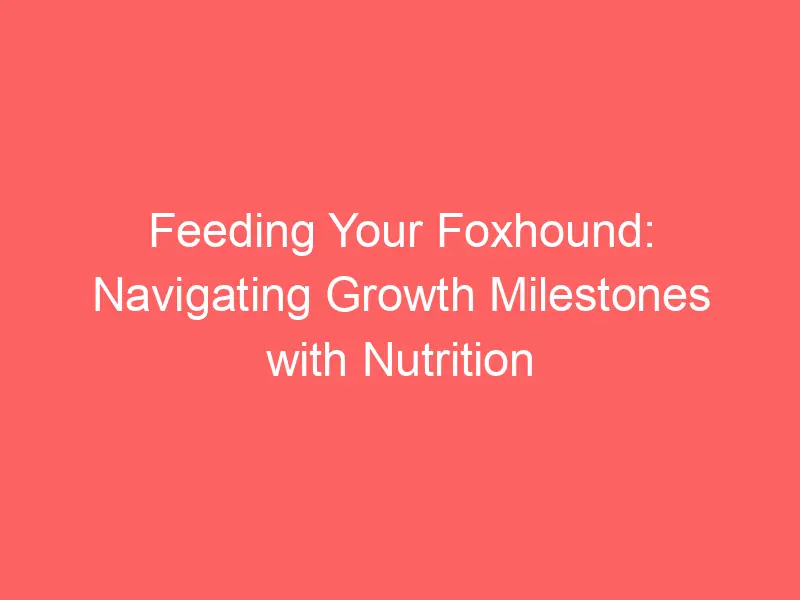
Introduction to Foxhound Feeding Guide
Feeding your Foxhound properly is a critical aspect of pet ownership. It’s not just about filling their bowl with food every day. It’s about understanding their nutritional needs and providing a balanced diet that promotes their overall health and well-being. This guide will help you understand the importance of nutrition in Foxhounds and provide an overview of a Foxhound feeding guide.
- Understanding the Importance of Nutrition in Foxhounds
- Overview of the Foxhound Feeding Guide
Foxhounds, like any other breed, have specific nutritional needs. Their diet plays a significant role in their health, growth, and development. A balanced diet for a Foxhound should include proteins, carbohydrates, fats, vitamins, and minerals. Proteins are essential for muscle development, while carbohydrates provide the energy they need for their active lifestyle. Fats are necessary for skin and coat health, and vitamins and minerals are vital for various bodily functions.
Feeding your Foxhound a balanced diet can help prevent health issues such as obesity, heart disease, and bone problems. It can also boost their immune system, making them less susceptible to illnesses. Therefore, understanding the importance of nutrition in Foxhounds is the first step towards ensuring their long and healthy life.
Feeding your Foxhound properly involves more than just choosing the right food. It also includes knowing how much and how often to feed them. Foxhounds are active dogs, and their dietary needs may vary depending on their age, size, and activity level.
Puppies generally need to be fed more often than adult dogs because they are growing and developing. As they grow older, their feeding frequency can be reduced, but the portion size may need to be increased. Adult Foxhounds, on the other hand, may require fewer calories if they are less active. It’s also important to monitor your Foxhound’s weight and adjust their diet accordingly to prevent obesity.
This guide will provide more detailed information on how to feed your Foxhound at different stages of their life, from puppyhood to adulthood. It will also offer tips on maintaining a healthy diet for your Foxhound.
Understanding Foxhound Growth Milestones
Just like humans, Foxhounds go through different stages of growth. Each stage is unique and requires different care and attention. Understanding these stages can help you provide the best care for your Foxhound.
Stages of Foxhound Growth
Let’s delve into the four primary stages of a Foxhound’s growth:
- Puppy Stage
- Adolescent Stage
- Adult Stage
- Senior Stage
This is the first stage of a Foxhound’s life, from birth to about six months. During this time, your Foxhound will grow rapidly. They will need plenty of nutrition to support their growth. It’s also a crucial time for socialization, so introduce them to different people, animals, and environments.
The adolescent stage typically begins at six months and lasts until the Foxhound is about two years old. This is a time of physical and mental development. Your Foxhound will be full of energy and curiosity. Training and discipline are important during this stage to shape their behavior.
The adult stage begins around two years of age and lasts until the Foxhound is about seven. During this stage, your Foxhound will be at their physical peak. They will require regular exercise and a balanced diet to maintain their health. Regular vet check-ups are also essential.
The senior stage begins around seven years of age. As your Foxhound ages, they may become less active and require fewer calories. However, they still need a balanced diet and regular exercise. Regular vet check-ups are important to monitor for any health issues.
Understanding these stages of growth can help you provide the best care for your Foxhound at each stage of their life. Remember, every Foxhound is unique and may grow at a different rate. Always consult with your vet if you have any concerns about your Foxhound’s growth or health.
Nourishing a Growing Foxhound
As your Foxhound puppy grows, it’s crucial to understand the importance of balanced nutrition and how to avoid common nutritional deficiencies. Let’s delve into these topics.
- Importance of Balanced Nutrition During Growth
Just like humans, Foxhounds need a balanced diet to grow and develop healthily. A balanced diet provides the essential nutrients your Foxhound needs to build strong bones, develop a robust immune system, and maintain a healthy coat and skin.
Proteins, fats, carbohydrates, vitamins, and minerals are all vital components of a balanced diet. Proteins are the building blocks of body tissues, while fats provide energy and help absorb vitamins. Carbohydrates provide energy, and vitamins and minerals are necessary for various bodily functions.
Feeding your Foxhound a balanced diet from puppyhood can prevent health issues in the future. It can also contribute to a longer, healthier life for your beloved pet.
- Common Nutritional Deficiencies and How to Avoid Them
Despite our best efforts, Foxhounds can sometimes suffer from nutritional deficiencies. Some of the most common deficiencies include lack of protein, calcium, and certain vitamins and minerals.
A protein deficiency can lead to weight loss, muscle wasting, and a dull coat. Calcium deficiency can result in weak bones and teeth. A lack of certain vitamins and minerals can lead to various health issues, including poor immune function and skin problems.
To avoid these deficiencies, ensure your Foxhound’s diet is varied and balanced. Include high-quality animal proteins, healthy fats, complex carbohydrates, and a variety of fruits and vegetables. Also, consider adding a multivitamin supplement to your Foxhound’s diet, especially during the growth phase.
Remember, every Foxhound is unique, and what works for one may not work for another. It’s always best to consult with a veterinarian or a canine nutritionist to create a tailored diet plan for your Foxhound.
Foxhound Puppy Feeding
Feeding your Foxhound puppy correctly is crucial for their growth and overall health. This section will help you understand the nutritional needs of your Foxhound puppy and recommend some of the best puppy food brands.
Understanding Foxhound Puppy Nutrition
Just like human babies, Foxhound puppies have different nutritional needs compared to adult dogs. They require a balanced diet rich in essential nutrients to support their rapid growth and development. Let’s delve into the key nutrients your Foxhound puppy needs and the best food brands that provide them.
- Essential nutrients for Foxhound puppies
- Protein: Protein is vital for your puppy’s growth and muscle development. It should make up about 22% of your puppy’s diet.
- Fats: Fats provide energy and help in brain development. They should make up about 8% of your puppy’s diet.
- Carbohydrates: Carbohydrates provide energy and aid in digestion. They should make up about 30% of your puppy’s diet.
- Vitamins and Minerals: Vitamins and minerals support bone growth, immune function, and overall health. They should be included in your puppy’s diet in appropriate amounts.
- Recommended puppy food brands
Your Foxhound puppy’s diet should include the following essential nutrients:
Choosing the right food for your Foxhound puppy can be overwhelming with the numerous brands available. Here are some of the best puppy food brands that provide the essential nutrients your Foxhound puppy needs:
| Brand | Key Features |
|---|---|
| Purina Pro Plan Puppy | High in protein, contains DHA for brain and vision development |
| Blue Buffalo Life Protection Formula Puppy | Contains real meat, whole grains, and garden veggies |
| Royal Canin Medium Puppy | Designed for puppies up to 12 months old, supports digestive health and natural defenses |
Remember, every Foxhound puppy is unique and may have different dietary needs. Always consult with your vet before making any significant changes to your puppy’s diet.
Foxhound Puppy Feeding Schedule
Feeding your Foxhound puppy correctly is crucial for their growth and overall health. In this section, we will discuss how often to feed a Foxhound puppy and the appropriate portion sizes for different growth stages.
- How often to feed a Foxhound puppy
- Portion sizes for different growth stages
During the first three months, it is recommended to feed your Foxhound puppy four times a day. As they grow older, you can gradually reduce the frequency. From 3 to 6 months, three meals a day are sufficient. After 6 months, you can switch to two meals a day, which can be continued into adulthood.
Portion sizes vary depending on the puppy’s age, size, and activity level. A general guideline is to feed them 1 cup of food for every 10 pounds of their body weight daily. However, this amount should be divided into the number of meals they have per day. For instance, if your 20-pound puppy eats three times a day, they should receive approximately 2/3 cup of food at each meal.
Remember, these are general guidelines. Every puppy is unique, and their feeding requirements may vary. Always consult with your vet to determine the best feeding schedule and portion sizes for your Foxhound puppy.
| Age | Feeding Frequency | Portion Size (per meal) |
|---|---|---|
| 1-3 months | 4 times a day | Depends on weight |
| 3-6 months | 3 times a day | Depends on weight |
| 6 months onwards | 2 times a day | Depends on weight |
Feeding your Foxhound puppy might seem complicated at first, but with time and patience, you’ll soon become an expert. Always monitor your puppy’s growth and adjust their diet as needed. A well-fed Foxhound puppy is a happy and healthy one!
Adult Foxhound Diet
As your Foxhound grows, their dietary needs change. It’s crucial to understand when and how to transition your Foxhound from a puppy diet to an adult diet. This transition is a significant milestone in your Foxhound’s life, and doing it correctly can ensure they grow into a healthy, happy adult.
Transitioning from Puppy to Adult Diet
Let’s delve into the specifics of this transition process:
- When to transition your Foxhound to adult food
- How to make the transition smooth
Typically, Foxhounds should begin transitioning to adult food when they reach about one year of age. However, this can vary depending on your dog’s size, activity level, and overall health. It’s always best to consult with your vet to determine the right time for this transition.
Transitioning your Foxhound to adult food should be a gradual process to avoid upsetting their digestive system. Start by mixing a small amount of adult food into their puppy food, gradually increasing the proportion of adult food over a period of 7-10 days. This slow transition will help your Foxhound adjust to the new diet without any digestive issues.
Remember, every Foxhound is unique, and what works for one might not work for another. Always monitor your Foxhound’s reaction to the new diet and adjust as necessary. If you notice any adverse reactions, such as loss of appetite, upset stomach, or changes in behavior, consult your vet immediately.
Transitioning your Foxhound to an adult diet is a significant step in their growth. By understanding when and how to make this transition, you can ensure your Foxhound continues to thrive and enjoy a healthy, happy life.
Understanding Adult Foxhound Food Requirements
Feeding your adult Foxhound properly is crucial for their health and happiness. It’s not just about the quantity of food, but also the quality. Let’s take a closer look at what your Foxhound needs in their diet.
- Essential nutrients for adult Foxhounds
- Recommended adult food brands
- Blue Buffalo Wilderness High Protein Dry Dog Food: This food is grain-free and packed with real chicken to help satisfy your Foxhound’s natural love for meat.
- Nutro Ultra Adult Dry Dog Food: This brand offers a blend of 15 vibrant superfoods like coconut, chia, kale, and blueberries, which are all part of a balanced diet.
- Wellness Core Natural Grain Free Dry Dog Food: This grain-free dog food is made with premium chicken and turkey. It includes vegetables, fruits, and probiotics for a balanced diet.
Adult Foxhounds require a balanced diet that includes a variety of essential nutrients. Here are some of the key ones:
| Nutrient | Why It’s Important |
|---|---|
| Protein | Protein is vital for muscle development and repair. It also supports a healthy immune system. |
| Fats | Fats provide energy and help absorb vitamins. They also keep your Foxhound’s coat shiny and healthy. |
| Carbohydrates | Carbohydrates provide energy and help with digestion. They should be complex carbs, like whole grains. |
| Vitamins and Minerals | Vitamins and minerals are needed for various bodily functions, like bone health and blood clotting. |
There are many high-quality dog food brands suitable for adult Foxhounds. Here are a few recommendations:
Remember, every dog is unique. What works best for one Foxhound might not work as well for another. It’s always a good idea to consult with your vet before making any major changes to your dog’s diet.
Maintaining a Healthy Diet for Foxhounds
Keeping your Foxhound healthy and happy involves more than just regular exercise. A balanced and consistent diet plays a crucial role in their overall well-being. Here are some tips to help you maintain a healthy diet for your Foxhound.
Foxhound Feeding Tips
- How to maintain a consistent feeding schedule
- Tips for preventing overfeeding
Consistency is key when it comes to feeding your Foxhound. Establish a regular feeding schedule and stick to it. This not only helps in digestion but also keeps your Foxhound’s metabolism stable. A typical adult Foxhound should be fed twice a day, once in the morning and once in the evening. Puppies may require more frequent meals.
Overfeeding can lead to obesity, a common health issue among Foxhounds. To prevent this, measure your Foxhound’s food portions accurately and avoid giving them too many treats. It’s also important to monitor their weight regularly. If you notice any sudden weight gain, consult your vet for advice.
Remember, a healthy diet is not just about the quantity but also the quality of food. Ensure your Foxhound’s diet includes a balance of proteins, carbohydrates, and fats. And don’t forget, always have fresh water available for your Foxhound.
Foxhound Diet Milestones
As a Foxhound owner, it’s important to understand and recognize the significant diet milestones in your dog’s life. These milestones are not just about celebrating growth, but also about adjusting their diet to meet their changing nutritional needs. Let’s dive into these milestones and learn how to keep your Foxhound healthy and happy.
- Recognizing and Celebrating Diet Milestones
- How Diet Changes as Your Foxhound Ages
Just like humans, dogs have diet milestones that we should recognize and celebrate. These milestones are crucial indicators of your Foxhound’s growth and development. For instance, the transition from puppy food to adult food is a significant milestone that usually happens around one year of age. This transition is a cause for celebration, as it signifies that your Foxhound is growing and developing as expected.
Another important milestone is the transition to senior dog food, which typically occurs around seven years of age. This change in diet is essential to ensure that your Foxhound gets the nutrients needed for a healthy and active senior life. Recognizing these milestones not only helps you keep track of your Foxhound’s growth but also allows you to adjust their diet accordingly.
As your Foxhound ages, their dietary needs change. Puppies require a diet rich in protein and fat to support their rapid growth and development. As they transition into adulthood, their diet should be adjusted to maintain a healthy weight and support their active lifestyle. This usually means a balanced diet that includes high-quality protein, carbohydrates, fats, vitamins, and minerals.
When your Foxhound reaches their senior years, their metabolism slows down, and they may become less active. As a result, they may require fewer calories, but still need a diet rich in high-quality protein to maintain muscle mass. They may also need more fiber to support digestive health, and certain supplements to support joint health. Always consult with your vet to determine the best diet for your aging Foxhound.
In conclusion, understanding your Foxhound’s diet milestones is key to providing them with the best possible care. By recognizing and celebrating these milestones, and adjusting their diet as they age, you can ensure that your Foxhound stays healthy and happy throughout their life.
Conclusion
In this comprehensive guide, we’ve explored the importance of nutrition in Foxhounds and how it contributes to their overall health and well-being. Let’s recap some of the key points.
- Recap of the importance of nutrition in Foxhounds: Nutrition is the foundation of a Foxhound’s health. A balanced diet ensures they have the energy for their active lifestyle, supports their immune system, and promotes a shiny coat and healthy skin. It’s also crucial for their growth and development, especially in puppies. Remember, each Foxhound is unique and their nutritional needs may vary based on their age, size, and health condition.
- Final thoughts on Foxhound feeding guide: Feeding your Foxhound isn’t just about providing food. It’s about understanding their specific nutritional needs and ensuring they’re met. This includes the right balance of proteins, carbohydrates, fats, vitamins, and minerals. Regular vet check-ups can help monitor their health and adjust their diet as needed. Remember, a well-fed Foxhound is a happy and healthy Foxhound.
By following the guidelines in this Foxhound feeding guide, you can ensure your furry friend enjoys a long, healthy, and active life. Here’s to many happy years with your Foxhound!








